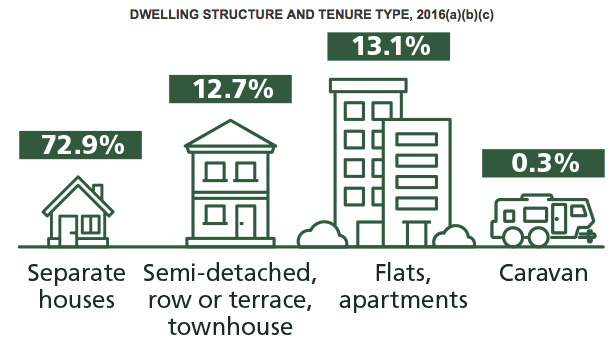Why townhouses are the next big thing
Over the last five years, medium density housing (townhouse, terrace and semi-detached) has become more popular than ever before, with the latest research suggesting this trend is set to continue over the coming years. As the cost of land skyrockets and the great Australian dream of a big backyard becomes unreachable for many, the humble townhouse is making a comeback. For property investors seeking to build a diverse portfolio, it is important to understand why a townhouse has such great and growing appeal across all the major Australian capital cities, and how the types of townhouses being developed are changing to adapt to the needs of a growing population.
THE CHANGING NATURE OF HOUSING IN AUSTRALIA’S CAPITAL CITIES
According to CoreLogic Research Analyst, Cameron Kusher, data from the 2016 Census shows that over the last five years there has been a noticeable shift towards higher density housing stock being built across all the capital cities.
“Interestingly, while driving around inner city areas you would be led to believe that it is higher density units which have been most abundant in new supply, [but] the data points to medium density supply having ramped up the most,” he said.

Infograph source: CoreLogic
While separate houses remain, overall, the most common housing type, this is quickly changing. For example, 10 years ago in Sydney, 61.7% of housing was separate houses, in the latest Census this has figure has decreased to 55.7%. Mr Kusher says that if this declining trajectory continues, by 2026 less than half of Sydney’s housing will be separate houses.
“With ongoing under investment in much needed infrastructure there are generally significant lifestyle benefits associated with living closer to the city centre however, the supply of land in the areas closer to the city centre is limited. This is leading to increasing levels of medium and higher density dwelling construction and premiums for detached housing located close to the city centres.
“Although approvals for these types of properties has slowed recently, it is anticipated that construction of medium and high density dwellings will remain elevated relative to historic levels. The shift towards a greater proportion of capital city housing being medium and high density is expected to continue over the coming years,” he said.
AN AFFORDABLE ALTERNATIVE
As land prices become increasingly higher, there has been a strong trend of creating smaller blocks of land to meet a more affordable price point. This situation is what has led to the creation of the townhouse as an affordable housing option.
A growing population is a key factor which influences housing demand, and as the population continues to seek affordable housing options in the capital cities, medium and higher density housing can address this need.

Source: ABS
Townhouses now account for 12.7 percent of resident homes in Australia, according to the 2016 Census, up from 9.9% in 2011. The best townhouse developments are architecturally designed, located within established or establishing communities and are close to schools and shops. They offer a greater level of privacy than apartments, and form a family-friendly alternative to a separate house, at a lower entry-price. Townhouses come in a range of sizes and prices, so that they can offer similar amenity to a house in terms of internal layout and access to outdoor space.
LIFESTYLE APPEAL AND CONVENIENCE
Townhouses are often lower maintenance compared to house and land, making them highly desirable not only to young families or first-home-buyers but also to downsizing retirees or other tenants who are attracted to the “lock up and leave” lifestyle.
Townhouses are often located closer to the CBD or close to convenient transport nodes, making the commute to employment centres more viable. The growing trend for master planned townhouse developments is to focus on community spaces, which in turn has a greater social benefit to the local communities.
“Developers are investing in community spaces such as parks, play areas and BBQ facilities, so residents will get out of their homes and engage with their neighbours more, hence creating a better sense of community compared to other dwelling types,” said Ironfish Head of Property, William Mitchell.

TWO-BEDROOM SURGE
“In the face of affordability constraints, changing lifestyle choices and a swelling population, townhouse living is likely to grow in popularity,” says Domain Group Data Scientist, Dr Nicola Powell.
Dr Powell also says that developers are proving the popularity of townhouses, with nearly 8000 townhouses approved for construction in NSW alone. This figure falls marginally behind the peak experienced in the early 1990s, according to ABS building figures. The major difference between the peaks is densification and the move from single-storey townhouses to two-storey plus developments.
Another significant change in the types of townhouses being built is the increasing number of two-bedroom townhouses on offer.
“Two-bedroom townhouses essentially turbo-charge the key benefits of a traditional three-bedroom townhouse, as they offer even greater affordability for buyers. They also appeal strongly to downsizers who want the same type of layout and outdoor space as a house, but don’t necessarily need that 3rd bedroom,” Mr Mitchell said.
The Ironfish Portfolio Approach is designed to take advantage of the unique benefits of each of three major residential housing types, with townhouses forming a key element of this strategy. For more information about the benefits of building a diversified portfolio – both geographically and in terms of housing type – please join one of our next property investment seminars located across Sydney, Brisbane, Melbourne, Adelaide and Perth.